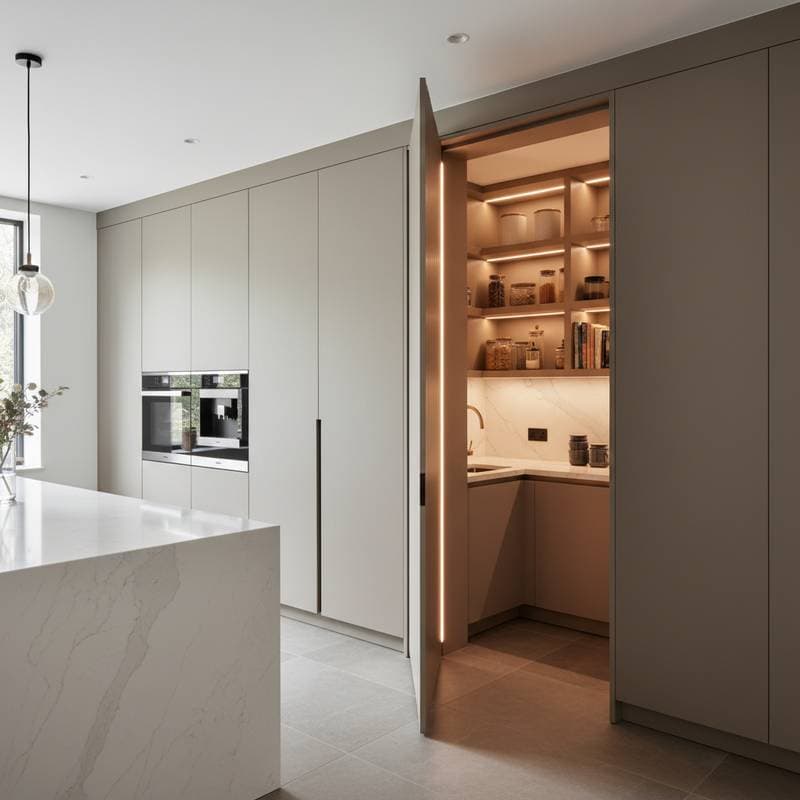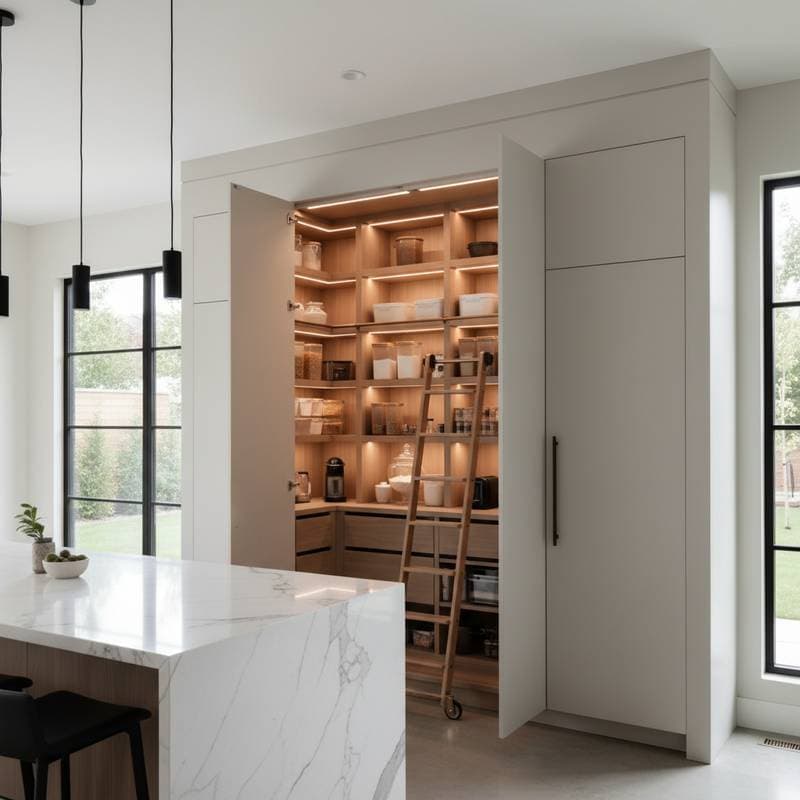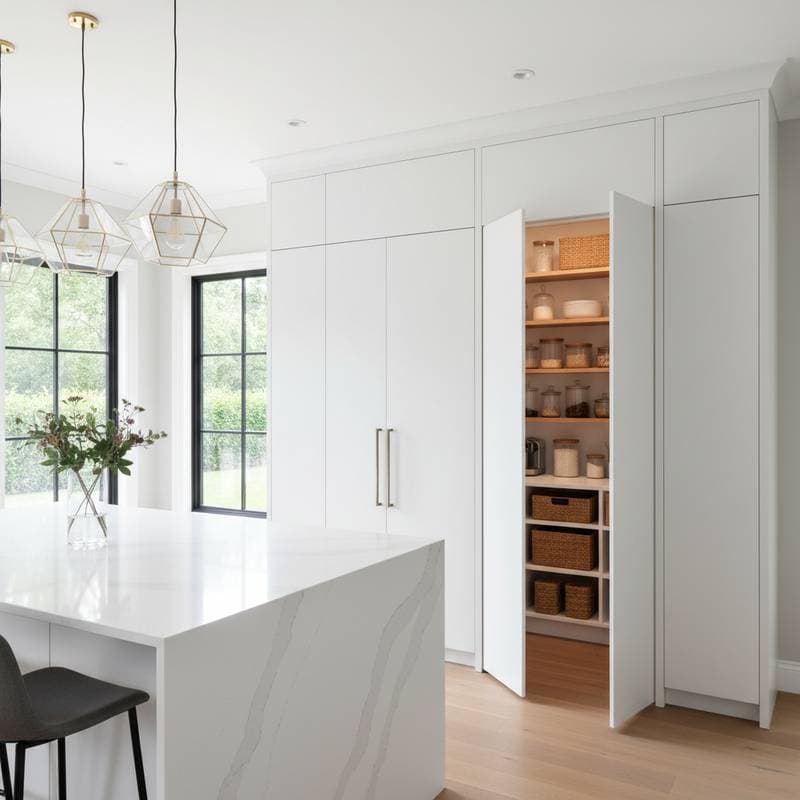Hidden Pantries: A $18,000 Boost to Kitchen Resale Value
Typical return: Approximately $18,000 added to resale value for a midrange hidden pantry project.
A hidden pantry transforms a kitchen by creating a cleaner, more spacious appearance while concealing clutter and accommodating bulk storage items. This design choice maintains the room's visual harmony. When executed with precise planning, high-quality construction, and an efficient layout, the investment delivers substantial returns.
Key Cost Factors
Hidden pantry projects involve several expense categories. Understanding these elements helps homeowners budget effectively and avoid surprises.
1. Materials and Finishes
Options such as plywood, medium-density fiberboard (MDF), or solid wood panels influence the overall price. Budget $1,500 to $4,000 for cabinetry, doors, and trim components. Paint-grade panels prove more affordable than custom veneers, which demand higher craftsmanship.
2. Labor and Design
Custom carpentry and framing typically contribute $3,000 to $8,000 to the total. Engaging a designer or architect incurs an additional $1,000 to $2,500, yet this step minimizes errors in layout and functionality.
3. Size and Layout
A full walk-in pantry demands greater investment than a pull-out or cabinet-integrated design. Each additional foot of depth increases costs by $300 to $500, covering both materials and labor adjustments.
4. Access and Structural Modifications
These pantries frequently integrate behind wall panels, sliding doors, or disguised cabinetry. Necessary structural alterations or plumbing relocations can elevate expenses by $2,000 to $4,000.
5. Permits and Electrical Work
Interior lighting and outlets often necessitate permits, with fees ranging from $200 to $500. Basic electrical installations add $400 to $800, ensuring safe and compliant power sources.
6. Demolition and Preparation
Fees for demolition and waste disposal reach $300 to $700, particularly when walls require removal or repair. Proper site preparation sets the foundation for smooth installation.
7. Optional Enhancements
Features like motion-activated lighting, concealed hinges, or ventilation systems contribute $500 to $1,500. Such additions enhance daily usability, though they increase the project's scope.
Overall costs for a hidden pantry range from $9,000 to $25,000, depending on scale and customization. Selecting midrange options balances affordability with lasting appeal.
Ensuring Safety and Regulatory Compliance
Safety remains paramount during installation to prevent hazards and ensure longevity.
- Shut off electrical power before cutting into walls that may contain wiring.
- Verify local building codes for any new outlets, lighting, or ventilation systems.
- Select moisture-resistant materials if the pantry adjoins exterior walls or plumbing.
- Wear safety glasses and a dust mask during tasks involving wood or drywall cutting.
- Employ a licensed electrician for all new circuit installations.
Neglecting these precautions risks code violations, electrical issues, or moisture-related problems like mold growth.
Project Timeline and Cost-Saving Strategies
Most hidden pantry installations span 3 to 6 weeks, from initial design to final touches. This timeframe allows for thorough execution without undue haste.
- Week 1: Conduct design consultations and precise measurements.
- Weeks 2-3: Order materials and coordinate delivery schedules.
- Weeks 4-6: Perform construction, followed by painting and finishing.
Potential Delays
Custom doors or panels may extend the timeline by 2 to 3 weeks. Supply chain interruptions for hinges or specialized hardware occur frequently, so plan buffers accordingly.
Strategies for Savings
Repurpose existing wall framing to reduce structural costs. Opt for painted MDF panels over solid wood for a cost-effective finish. Install motion sensors to avoid intricate wired switch setups. Seek trade discounts when purchasing bulk shelving materials.
Incentive Opportunities
Certain energy efficiency programs provide rebates for LED motion lighting installations. Consult with your contractor about eligible fixtures to offset expenses.
Resale Value and Market Advantages
Hidden pantries emerge as a compelling feature in competitive real estate markets. Homebuyers prioritize kitchens that combine openness with ample storage, viewing this upgrade as a marker of thoughtful design.
Real estate professionals note that a well-integrated hidden pantry elevates perceived kitchen value by $15,000 to $20,000, particularly in midrange to upscale neighborhoods. The return on investment reaches 80 to 100 percent, especially alongside comprehensive kitchen renovations. Properties with seamless built-in storage tend to attract offers more quickly than comparable homes lacking such elements.
Reasons for Strong Appeal
The design promotes visual simplicity, improving how kitchens appear in photographs for listings. Buyers perceive it as a bespoke, high-end touch. By minimizing countertop clutter, it facilitates smoother showings and daily living.
For optimal resale impact, select neutral finishes and prioritize practical layouts. Avoid oversized or elaborate doors that may appear outdated; instead, favor clean lines and subtle hardware for enduring style.
Steps to Implement Your Hidden Pantry
Taking structured action ensures a successful project. Follow these guidelines to proceed confidently.
-
Measure Available Space
Locate areas offering at least 24 inches of depth, such as behind cabinetry or adjacent to walls suitable for repurposing. -
Establish a Budget
Allocate funds with a 10 to 15 percent contingency to accommodate discoveries during wall openings. -
Engage Professionals
Schedule a design session with a carpenter or designer to identify potential layout challenges early. -
Obtain Multiple Quotes
Solicit at least two detailed bids, reviewing breakdowns for materials, labor, and finishes. Inquire about expected timelines and hardware availability. -
Incorporate Lighting Plans
Determine preferences for motion-activated or switch-controlled lights prior to drywall modifications. -
Time the Project Wisely
Initiate work during dry seasons to prevent humidity from delaying paint and finish applications. -
Document the Work
Retain invoices, photographs, and permits as evidence of quality upgrades, building buyer confidence.
A thoughtfully designed hidden pantry merges utility with elegance, delivering organization, clear surfaces, and enhanced market value. With careful planning and skilled execution, this addition elevates your kitchen's functionality and positions it for a compelling $18,000 increase in resale potential.










